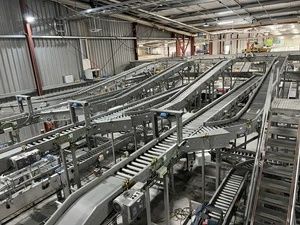Explore Custom Conveyor Solutions: A Complete Guide to Streamlining Operations
Conveyor are essential in modern industries, which helps companies to move the material efficiently and well. While standard systems exist, customized transport solutions are designed to meet specific operating requirements, making them quickly valuable in production, logistics, food processing and other fields. This guide examines references, significance, latest development, regulations, equipment and often asked questions about the customized carrier solutions.
Conveyors systems have been used for more than a century, which are initially designed to automate material handling in factories. Standard carriers work well in many environments, but industries with unique layouts, special products or high light requirements often require more adaptable systems.
Custom Conveyors solutions are designed to meet these requirements. They provide flexibility in dimensions, material selection and integration with automatic machines. Industries such as cars, e-commerce, drugs and food production are more dependent on these systems to:
-
Reduce manual labor
-
Improve safety
-
Ensure frequent product flow
Meaning: Why does this topic mean today
Custom transport solutions mean something today because industries face increasing challenges such as:
-
Efficiency demand – modern supply chains require speed and accuracy to remain competitive.
-
Work shortage – Automation reduces the dependence of manual handling.
-
Workplace safety – Silized carriers reduce the risk associated with duplication or dangerous environment.
-
Stability target – energy-capable carriers Design helps to reduce the environmental impact.
Manufacturers, warehousers, logistics and stakeholders as production planners benefit from understanding how these systems work, and they play a role in streamlining operations.
Newer updates and trends
Over the past year, many trends and developments have shaped industries how to use custom carriers:
-
Automation integration (2024–2025): Robotics, vision systems and artificial intelligence are quickly associated with quickly to improve the accuracy of the carrier.
-
Modular Transport Design: Many companies now prefer modular systems that allow rapid changes without complete compensation.
-
Energy efficiency standards: Reduce consumption of advance energy in motor technology and smart sensors.
-
E-commerce expansion: The rapid development of online shopping has continued the demand for customized carriers in distribution centers.
-
Smart monitoring: Real-time tracking with IoT sensor becomes standard in industries such as food and drugs.
These trends indicate a change from carriers that are static tools that are in the form of intelligent, adaptable parts of the production ecosystem.
Law, guidelines and standards
The government's political and industry standards play an important role that carriers design and operate. Some relevant areas include:
-
Professional security regulations: In other countries, agencies such as OSHA (U.S.) or similar bodies determine safety requirements for conveyor systems including protective and emergency stop mechanisms.
-
Standards for food security: In industries such as food and medicines, carriers should follow the FDA guidelines or hygiene standards such as the EU's rules.
-
Environmental policy: Energy efficiency rules encourage industries to use low -power engines and carriers using recycled materials.
-
International standards: ISO standard for material management equipment affects global practice, and ensures that quality and security compliance.
Understanding this policy helps organizations to choose carriers that meet both operational and legal needs.
Tools and resources
Many equipment and resources are available to support organizations when planning or controlling conveyor systems:
-
Design software: CAD-based platform engineers allow the carrier's system to model before installation.
-
Simulation equipment: Digital twins help to guess how carriers will work under different load conditions.
-
Industrial Association: Organizations such as Cemyor Equipment Maker Association) provide guidelines and publications.
-
Online calculator: Transport capacity and belt speed aid with calculator scheme.
-
Resource Library: websites for business associations and universities often share research, case studies and best exercises.
Comparison Table: Standard vs. Custom Conveyor Solutions
| Feature | Standard Conveyor | Custom Conveyor |
|---|---|---|
| Flexibility | Limited | High – tailored to layout and product needs |
| Integration with Tech | Basic | Advanced – can link with robotics, AI, IoT |
| Maintenance | General | Specific – designed per system |
| Cost Efficiency (Long-term) | Moderate | High – reduces downtime and increases ROI |
| Compliance with Standards | Generic | Custom-fit to meet industry regulations |
Question to ask
What industries benefit most from customized transport solutions?
Industries such as production, food processing, e-commerce logistics, drugs and automotive industry have great benefits as they require accurate, reliable and optimal systems.
Are customized conveyor systems just for large companies?
No, while large companies often use them, small and medium -sized companies also take custom solutions to improve special operations and safety in special operations.
How do carriers support stability?
Energy-capable engines, recycled materials and smart surveillance systems reduce power consumption and correspond to environmental goals, the system expands the service life.
What factors should be considered before using customized carrier?
Important ideas include material types, product size, necessary speed, space availability and compliance with safety and industry standards.
Can conveyor belts be integrated with other automation systems?
Yes. Modern carriers can integrate with robotics, packaging equipment and AI operated monitoring system, making them central to smart factory operations.
Conclusion
Custom carrier solutions are no longer alternative to many industries - they are a need to achieve efficiency, safety and stability. Along with the forming of industries such as automation, modular design and smart monitoring, which will show benefits of long -term benefits for optimized organizations. By understanding guidelines, taking advantage of available equipment and asking the right questions, the decision -makers can ensure that the carrier's systems actually support their operating goals.
Adapted carriers represent a change in intelligent, adaptive systems from standard material handling that correspond to modern industrial requirements.
